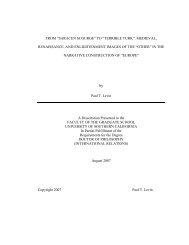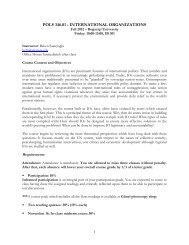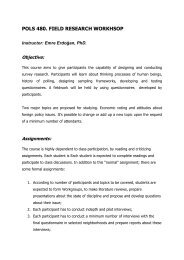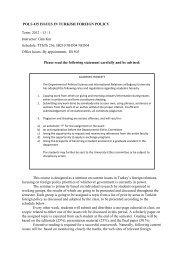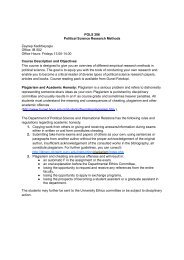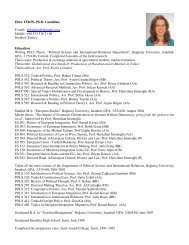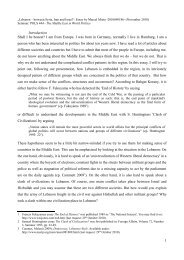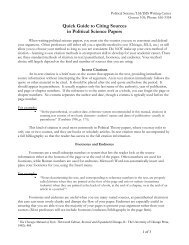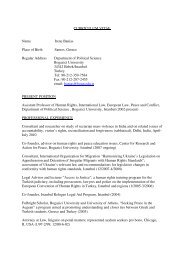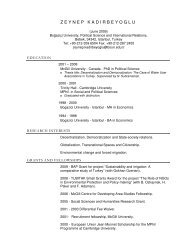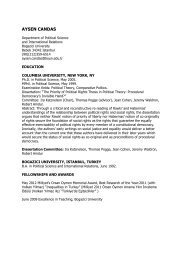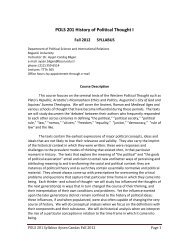Geopolitical Determinism: The Origins of the Iran-Iraq War
Geopolitical Determinism: The Origins of the Iran-Iraq War
Geopolitical Determinism: The Origins of the Iran-Iraq War
You also want an ePaper? Increase the reach of your titles
YUMPU automatically turns print PDFs into web optimized ePapers that Google loves.
<strong>Geopolitical</strong> <strong>Determinism</strong>: <strong>The</strong> <strong>Origins</strong> <strong>of</strong> <strong>the</strong> <strong>Iran</strong>-<strong>Iraq</strong> <strong>War</strong><br />
Author(s): Efraim Karsh<br />
Source: Middle East Journal, Vol. 44, No. 2 (Spring, 1990), pp. 256-268<br />
Published by: Middle East Institute<br />
Stable URL: http://www.jstor.org/stable/4328101 .<br />
Accessed: 31/03/2011 12:10<br />
Your use <strong>of</strong> <strong>the</strong> JSTOR archive indicates your acceptance <strong>of</strong> JSTOR's Terms and Conditions <strong>of</strong> Use, available at .<br />
http://www.jstor.org/page/info/about/policies/terms.jsp. JSTOR's Terms and Conditions <strong>of</strong> Use provides, in part, that unless<br />
you have obtained prior permission, you may not download an entire issue <strong>of</strong> a journal or multiple copies <strong>of</strong> articles, and you<br />
may use content in <strong>the</strong> JSTOR archive only for your personal, non-commercial use.<br />
Please contact <strong>the</strong> publisher regarding any fur<strong>the</strong>r use <strong>of</strong> this work. Publisher contact information may be obtained at .<br />
http://www.jstor.org/action/showPublisher?publisherCode=mei. .<br />
Each copy <strong>of</strong> any part <strong>of</strong> a JSTOR transmission must contain <strong>the</strong> same copyright notice that appears on <strong>the</strong> screen or printed<br />
page <strong>of</strong> such transmission.<br />
JSTOR is a not-for-pr<strong>of</strong>it service that helps scholars, researchers, and students discover, use, and build upon a wide range <strong>of</strong><br />
content in a trusted digital archive. We use information technology and tools to increase productivity and facilitate new forms<br />
<strong>of</strong> scholarship. For more information about JSTOR, please contact support@jstor.org.<br />
Middle East Institute is collaborating with JSTOR to digitize, preserve and extend access to Middle East<br />
Journal.<br />
http://www.jstor.org
GEOPOLITICAL DETERMINISM: THE<br />
ORIGINS OF THE IRAN-IRAQ WAR<br />
Efraim Karsh<br />
XVAR, like any social phenomenon, has both its general and specific causes.<br />
On <strong>the</strong> general level, war can be an occasional outburst <strong>of</strong> a deep-rooted historical<br />
conflict. Such a conflict may arise from ethnic, national, or religious enmity, from<br />
competition over natural resources or territory, or over regional or global<br />
hegemony. <strong>The</strong> specific causes <strong>of</strong> war lie in <strong>the</strong> subjective interpretations <strong>of</strong> such<br />
historical conflict and assessments regarding adequate means for handling it at a<br />
given moment. Assessments derive from such factors as <strong>the</strong> world views, images,<br />
and beliefs <strong>of</strong> <strong>the</strong> relevant leaders, from bureaucratic politics (power struggles<br />
within <strong>the</strong> ruling elites), and from a combination <strong>of</strong> <strong>the</strong>se factors.<br />
In <strong>the</strong> case <strong>of</strong> <strong>the</strong> <strong>Iran</strong>-<strong>Iraq</strong> <strong>War</strong>, <strong>the</strong> general cause is <strong>of</strong>ten attributed to <strong>the</strong><br />
ethnic and religious divide that has separated Arabs and Persians, Shi'i and Sunni<br />
Muslims since at least <strong>the</strong> seventh century. One scholar's view is that, "Seen in<br />
a long-term historical perspective, <strong>the</strong> current <strong>Iran</strong>-<strong>Iraq</strong> <strong>War</strong> is just ano<strong>the</strong>r phase<br />
in a struggle between <strong>the</strong> two countries that stretches back a millenium or more. " I<br />
<strong>The</strong> war is "<strong>the</strong> latest outbreak in an age-old struggle between <strong>the</strong> Persians and<br />
Arabs for domination <strong>of</strong> <strong>the</strong> Gulf and <strong>the</strong> rich Tigris and Euphrates Valley to its<br />
north," according to ano<strong>the</strong>r observer <strong>of</strong> <strong>the</strong> conflict.2<br />
1. Stephen R. Grummon, <strong>The</strong> <strong>Iran</strong>-<strong>Iraq</strong> <strong>War</strong>: Islam Embattled (New York: Praeger for <strong>the</strong><br />
Georgetown Center for Strategic and International Studies, 1982), <strong>The</strong> Washington Papers Series, no.<br />
92, p. 1.<br />
2. Phebe Marr, <strong>The</strong> Modern History <strong>of</strong> <strong>Iraq</strong> (Boulder, CO: Westview Press, 1985), p. 291. For<br />
a similar view on <strong>the</strong> origins <strong>of</strong> <strong>the</strong> war see Jasim M. Abdulghani, <strong>Iraq</strong> and <strong>Iran</strong>: <strong>The</strong> Years <strong>of</strong> Crisis<br />
(London: Croom Helm, 1984), chapter 1.<br />
Efraim Karsh is a lecturer on regional security at <strong>the</strong> Department <strong>of</strong> <strong>War</strong> Studies, King's College, <strong>the</strong><br />
University <strong>of</strong> London. He is <strong>the</strong> author <strong>of</strong> <strong>The</strong> <strong>Iran</strong>-<strong>Iraq</strong> <strong>War</strong>: A Military Analysis (London:<br />
International Institute for Strategic Studies, 1987) and <strong>the</strong> editor <strong>of</strong> <strong>The</strong> <strong>Iran</strong>-<strong>Iraq</strong> <strong>War</strong>: Impact and<br />
Implications (London and New York: Macmillan and St. Martin's Press, 1989).<br />
MIDDLE EAST JOURNAL * VOLUME 44, NO. 2, SPRING 1990
IRAN-IRAQ * 257<br />
On <strong>the</strong> immediate level, <strong>the</strong> outbreak <strong>of</strong> <strong>the</strong> war is commonly explained by<br />
what may be called <strong>the</strong> grand design <strong>the</strong>ory. According to this <strong>the</strong>ory, <strong>the</strong> <strong>Iraq</strong>i<br />
invasion <strong>of</strong> <strong>Iran</strong> in September 1980 reflected President Saddam Hussein's ambitions.<br />
<strong>The</strong>se ranged from <strong>the</strong> occupation <strong>of</strong> <strong>Iran</strong>ian territory (<strong>the</strong> Shatt al-Arab and<br />
Khuzistan), through <strong>the</strong> infliction <strong>of</strong> "a humiliating and perhaps decisive defeat on<br />
<strong>the</strong> <strong>Iran</strong>ian revolution, which he found troublesome,"3 to <strong>the</strong> desire to assert <strong>Iraq</strong><br />
cas <strong>the</strong> preeminent Arab and Gulf state.<br />
This article <strong>of</strong>fers an alternative explanation for <strong>the</strong> occurrence <strong>of</strong> <strong>the</strong><br />
I]ran-<strong>Iraq</strong> <strong>War</strong>. It argues that geopolitics is <strong>the</strong> most important single factor that<br />
has influenced <strong>Iran</strong>ian-<strong>Iraq</strong>i relations for generations and, in consequence, accounts<br />
for <strong>the</strong> outbreak <strong>of</strong> <strong>the</strong> war. <strong>The</strong> eruption <strong>of</strong> <strong>the</strong> war, according to this<br />
<strong>the</strong>ory, is nei<strong>the</strong>r <strong>the</strong> direct extension <strong>of</strong> <strong>the</strong> ancient Arab-Persian rivalry nor <strong>the</strong><br />
outcome <strong>of</strong> a premeditated grand design; ra<strong>the</strong>r it is <strong>the</strong> product <strong>of</strong> <strong>the</strong> geopolitical<br />
interaction between two disparate neighbors. More concretely, <strong>the</strong> war began<br />
because <strong>the</strong> weaker state, <strong>Iraq</strong>, attempted to resist <strong>the</strong> hegemonic aspirations <strong>of</strong><br />
its stronger neighbor, <strong>Iran</strong>, to reshape <strong>the</strong> regional status quo according to its own<br />
image.<br />
ORIGINS OF IRANIAN-IRAQI RELATIONS<br />
Intriguing as it is, <strong>the</strong> emphasis on <strong>the</strong> deep-rooted historical animosity<br />
between Arabs and Persians suffers from two major flaws. First, it overlooks<br />
lengthy periods <strong>of</strong> cooperation between <strong>the</strong>se two groups, motivated both by<br />
shared religious and cultural affinities and by converging economic interests such<br />
as trade. Second, intensive as it was during <strong>the</strong> Umayyad (661-750) and <strong>the</strong> early<br />
Abbasid (750-945) caliphates, <strong>Iraq</strong>i-Persian interaction was disrupted in <strong>the</strong> latter<br />
part <strong>of</strong> <strong>the</strong> tenth century, with <strong>the</strong> de facto demise <strong>of</strong> <strong>the</strong> Abbasid Empire, to be<br />
resumed only in <strong>the</strong> aftermath <strong>of</strong> World <strong>War</strong> I.<br />
Thus, from 945 until <strong>the</strong> early sixteenth century, <strong>the</strong> vast territories occupying<br />
present-day <strong>Iran</strong> and <strong>Iraq</strong> were controlled, with occasional intervals, by<br />
successive dynasties, mainly <strong>of</strong> Mongol and Turkish origins: <strong>the</strong> Buwayhids<br />
(945-1055), <strong>the</strong> SelUuk Turks (1055-1157), <strong>the</strong> Hulagu, Timur, and Il-Khan<br />
Mongols (1219-1408), and <strong>the</strong> Turkoman Turks (1408-1499). With <strong>the</strong> reemergence<br />
<strong>of</strong> Persia as an independent regional empire under <strong>the</strong> Safavid dynasty<br />
(1500-1736), <strong>the</strong> area that is now <strong>Iraq</strong> became <strong>the</strong> battlefield for intermittent wars<br />
between <strong>the</strong> Ottomans and <strong>the</strong> Persians. <strong>The</strong>se wars, never<strong>the</strong>less, had nothing to<br />
do with Persian-Arab animosity; ra<strong>the</strong>r <strong>the</strong>y were <strong>the</strong> manifestation <strong>of</strong> a power<br />
3. Shaul Bakhash, <strong>The</strong> Reign <strong>of</strong> <strong>the</strong> Ayatollahs (London: Counterpoint, 1986), p. 125. For a<br />
similar view see also R.K. Ramazani, Revolutionary <strong>Iran</strong>: Challenge and Response in <strong>the</strong> Middle East<br />
(Baltimore and London: <strong>The</strong> Johns Hopkins University Press, 1988), p. 57; Anthony Cordesman, <strong>The</strong><br />
Gulf and <strong>the</strong> Search for Strategic Stability (Boulder, CO: Westview Press, 1984), pp. 645-46; William<br />
0. Staudenmaier, "A Strategic Analysis," in Shirin Tahir-Kheli and Shaheen Ayubi, eds., <strong>The</strong><br />
<strong>Iran</strong>-<strong>Iraq</strong> <strong>War</strong> (New York: Praeger, 1983), p. 37.
258 * MIDDLE EAST JOURNAL<br />
struggle between <strong>the</strong> two empires, colored with strong religious elements, for<br />
hegemony and domination.<br />
In o<strong>the</strong>r words, geopolitical realities formed <strong>the</strong> major impetus for <strong>the</strong> Safavid<br />
policy while ideological-religious factors played a supportive role, however<br />
important, by rallying public will behind <strong>the</strong> regime's strategic goals. Although<br />
religious zeal would occasionally cause Safavid rulers to overlook geopolitical<br />
considerations, to <strong>the</strong> Persians <strong>the</strong> landmass to <strong>the</strong>ir western frontier was merely<br />
a medium <strong>of</strong> advance for expansion or, alternatively, a useful buffer zone to<br />
separate Persia's holdings from its major regional rival, <strong>the</strong> Ottoman Empire.<br />
With <strong>the</strong> mutual decline <strong>of</strong> <strong>the</strong> Turkish and <strong>the</strong> Persian empires over <strong>the</strong> centuries<br />
and <strong>the</strong> appearance <strong>of</strong> new and more menacing threats from o<strong>the</strong>r directions-<br />
Russia and Great Britain-<strong>the</strong>se two rivals were gradually driven toward accommodation.<br />
<strong>The</strong>n followed a long host <strong>of</strong> bilateral treaties, most notably <strong>the</strong><br />
Erzerum agreements <strong>of</strong> 1823 and 1847. Indeed, <strong>the</strong> vagueness <strong>of</strong> <strong>the</strong>se two<br />
agreements on <strong>the</strong> issue <strong>of</strong> border demarcation, not dispelled by <strong>the</strong> 1911 Tehran<br />
and 1913 Constantinople protocols, was to remain a major bone <strong>of</strong> contention<br />
between <strong>Iran</strong> and <strong>Iraq</strong> into <strong>the</strong> late twentieth century. Just as <strong>the</strong> geopolitical<br />
factor had figured prominently in Persian-Ottoman affairs, so has it constituted <strong>the</strong><br />
framework for twentieth-century <strong>Iraq</strong>i-<strong>Iran</strong>ian bilateral relations. By and large,<br />
this relationship has reflected both <strong>the</strong> inherent problems and <strong>the</strong> converging<br />
interests emanating from direct physical contiguity between two uneven powers.<br />
To <strong>the</strong> newly established state <strong>of</strong> <strong>Iraq</strong> (1921) geography posed an existential<br />
challenge. Virtually a landlocked country, whose coastline on <strong>the</strong> Gulf is only 15<br />
kilometers long, and surrounded by four countries with at least two-Turkey and<br />
<strong>Iran</strong>-larger and irredentist, <strong>Iraq</strong> suffered from an inherent feeling <strong>of</strong> insecurity<br />
from <strong>the</strong> early days <strong>of</strong> its statehood. This "encirclement complex" is understandable.<br />
First, <strong>Iraq</strong>'s major source <strong>of</strong> income, oil, cannot be exported without <strong>the</strong><br />
goodwill <strong>of</strong> its neighbors, Syria and Turkey, or "without coming so close to<br />
<strong>Iran</strong>ian territory in <strong>the</strong> south that it cannot be said to enjoy territorial security at<br />
all for its principal means <strong>of</strong> survival."4 Second, as one <strong>of</strong> <strong>the</strong> successor states to<br />
<strong>the</strong> Ottoman Empire, <strong>Iraq</strong> inherited not a few Ottoman privileges- particularly<br />
favorable border agreements-without at <strong>the</strong> same time enjoying <strong>the</strong> imperial<br />
power or stature to support <strong>the</strong>se gains. This state <strong>of</strong> affairs aroused Turkish and<br />
<strong>Iran</strong>ian irredentism, which in turn exacerbated <strong>Iraq</strong>'s feeling <strong>of</strong> vulnerability.5<br />
<strong>The</strong> proximity <strong>of</strong> <strong>Iraq</strong>'s major strategic and economic assets to <strong>the</strong> Turkish<br />
and <strong>Iran</strong>ian frontiers has been no less worrisome for Baghdad. <strong>The</strong> nor<strong>the</strong>rn<br />
oil-rich provinces <strong>of</strong> Mosul and Kirkuk, for example, lie close to Turkey and <strong>Iran</strong>.<br />
whereas Baghdad and Basra are only 120 and 30 kilometers respectively from <strong>the</strong><br />
<strong>Iran</strong>ian border. <strong>The</strong> Shatt al-Arab, <strong>Iraq</strong>'s only outlet to <strong>the</strong> Persian Gulf, could be<br />
4. Claudia Wright, "Implications <strong>of</strong> <strong>the</strong> <strong>Iran</strong>-<strong>Iraq</strong> <strong>War</strong>," Foreign Affairs, vol. 59 (Winter<br />
1980/81), p. 277.<br />
5. Indeed, <strong>the</strong>re is a long-standing Turkish claim for <strong>the</strong> province <strong>of</strong> Mosul. Moreover, in 1922<br />
Turkey backed up this claim by military action.
IRAN-IRAQ * 259<br />
easily controlled by <strong>Iran</strong>. Finally, <strong>Iraq</strong>'s internal fragmentation along ethnic and<br />
religious lines-Kurds versus Arabs, Sunnis versus Shias-has had a weakening<br />
effect on <strong>the</strong> country by impeding <strong>the</strong> crystallization <strong>of</strong> an <strong>Iraq</strong>i national identity<br />
and by constituting a lodestone for external interference.6<br />
Compared with <strong>the</strong>se geostrategic predicaments, <strong>Iran</strong>'s position seems enviable.<br />
Not only is <strong>Iran</strong> a much larger country in territory and population, but its<br />
major strategic centers are located, by and large, deep inside <strong>the</strong> country-Tehran<br />
is some 700 kilometers inside <strong>Iran</strong>-and enjoy better topographical protection<br />
than do <strong>the</strong>ir <strong>Iraq</strong>i counterparts. Also, and in sharp contrast to <strong>Iraq</strong>'s highly<br />
restricted access to <strong>the</strong> Gulf, <strong>Iran</strong> possesses a long Gulf coastline <strong>of</strong> some 2,000<br />
kilometers which makes it <strong>the</strong> major contender for regional hegemony and<br />
prevents a crippling encirclement similar to that faced by <strong>Iraq</strong>.<br />
Yet, <strong>Iran</strong> faces a prime geostrategic constraint that for a long time mitigated<br />
its relative advantages over <strong>Iraq</strong>-namely its 1,700-kilometer border with <strong>the</strong><br />
Soviet Union. During <strong>the</strong> two centuries since <strong>the</strong> early 1720s, when Peter <strong>the</strong><br />
Great for <strong>the</strong> first time captured Persian territory, to <strong>the</strong> seizure <strong>of</strong> power by <strong>the</strong><br />
Bolsheviks in 1917, Russia gradually emerged as <strong>the</strong> principal security threat to<br />
<strong>Iran</strong>. Employing a wide spectrum <strong>of</strong> means that ranged from diplomatic pressures<br />
to economic penetration, to direct military intervention, czarist Russia conducted<br />
a persistent drive southward. In <strong>the</strong> peace treaties <strong>of</strong> Gulistan (1813) and<br />
Turkumanchai (1828), Persia lost to Russia most <strong>of</strong> its Caucasian possessions,<br />
gave up its right to maintain a navy on <strong>the</strong> Caspian Sea, which <strong>the</strong>reby became a<br />
Russian lake, and paid a humiliating indemnity <strong>of</strong> 20 million rubles.7<br />
<strong>The</strong> fact that <strong>the</strong> Russian thrust southward coincided with a growing British<br />
interest in <strong>the</strong> Persian Gulf did little to ease <strong>Iran</strong>'s position. On <strong>the</strong> contrary, from<br />
<strong>the</strong> nineteenth century onward, Persia became yet ano<strong>the</strong>r arena for Great Power<br />
competition with its adverse implications for this country. In 1907, following<br />
Russian-British reconciliation in <strong>the</strong> Triple Entente, <strong>the</strong> two powers partitioned<br />
Persia into spheres <strong>of</strong> influence, leaving a buffer zone between <strong>the</strong>m as an<br />
independent and neutral entity.8<br />
Ending <strong>the</strong> Russian military presence in Persia and abrogating all <strong>the</strong> treaties<br />
and concessions secured by <strong>the</strong> czarist regime, <strong>the</strong> communist revolution aroused<br />
Persian hopes <strong>of</strong> a modification in Russian policy. Yet Persia's rulers were quick<br />
to realize that Bolshevik Russia was not willing to distance itself from <strong>the</strong><br />
traditional czarist ambitions in <strong>the</strong>ir country, and, in May 1920, Soviet forces<br />
invaded and established <strong>the</strong> Soviet Republic <strong>of</strong> Gilan, <strong>the</strong> first case <strong>of</strong> a<br />
Soviet-sponsored communist regime in Asia.<br />
6. Marr, History <strong>of</strong> <strong>Iraq</strong>, p. 5: Majid Khadduri, Republican <strong>Iraq</strong> (London: Oxford University<br />
Press, 1969), pp. 3-5; Uriel Dann, <strong>Iraq</strong> Under Qassem (New York: Praeger, 1969), pp. 1-2.<br />
7. It is interesting to note, however, that <strong>the</strong>se treaties followed decisive Persian defeats in<br />
two wars initiated by <strong>the</strong>m, not Russia. For <strong>the</strong> full texts <strong>of</strong> <strong>the</strong> treaties see J.C. Hurewitz, ed.,<br />
Diplomacy in <strong>the</strong> Near and Middle East: A Documentary Record (Princeton, NJ: D. Van Nostrand<br />
Co., 1966), vol. I, pp. 84-6, 96-102.<br />
8. For <strong>the</strong> full text <strong>of</strong> <strong>the</strong> 1907 partition agreeement see Hurewitz, ibid., pp. 265-7.
260 * MIDDLE EAST JOURNAL<br />
Persia's apparent advantages in comparison to <strong>Iraq</strong> were also mitigated by<br />
Baghdad's special relationship with Great Britain. Until 1932, <strong>Iraq</strong> constituted an<br />
integral part <strong>of</strong> <strong>the</strong> British Empire, and from that date to 1958-when <strong>the</strong><br />
Hashemite dynasty was overthrown by General Abd al-Karim al-Qasim-it was<br />
an important block in <strong>the</strong> edifice <strong>of</strong> Britain's regional position. Thus, it was <strong>the</strong><br />
British factor that improved Baghdad's bargaining position vis-'a-vis Tehran<br />
during <strong>the</strong> 1930s, as illustrated by <strong>Iraq</strong>'s gains in <strong>the</strong> 1937 Shatt al-Arab<br />
agreement. During <strong>the</strong> 1920s, Britain had also shielded <strong>Iraq</strong> from Saudi encroachments.<br />
BALANCE OF WEAKNESS<br />
This was <strong>the</strong> geopolitical background against which <strong>Iran</strong>ian-<strong>Iraq</strong>i relations<br />
developed. On <strong>the</strong> one hand, <strong>the</strong>re was Persia with its marked geopolitical and<br />
geostrategic preponderance over <strong>Iraq</strong>, yet heavily constrained by its contiguity to<br />
a Great Power and fully mindful <strong>of</strong> <strong>Iraq</strong>'s close association with Great Britain. On<br />
<strong>the</strong> o<strong>the</strong>r hand lay <strong>Iraq</strong>, plagued by domestic fragmentation, suffering from an<br />
inherent "encirclement complex," and smaller and weaker than Persia. This<br />
delicate "balance <strong>of</strong> weakness" dictated mutual caution and restraint and led to<br />
a peaceful coexistence that lasted, with occasional vicissitudes, until <strong>the</strong> late<br />
1960s. To be sure, overriding interests to coexistence did not prevent <strong>the</strong><br />
occasional emergence <strong>of</strong> differences or frictions, most <strong>of</strong> which revolved around<br />
territorial issues. Yet both sides were equally inclined to resolve <strong>the</strong>ir disagreements<br />
through peaceful means, and even in those crises that most uncharacteristically<br />
involved <strong>the</strong> risk <strong>of</strong> a frontal confrontation, such as <strong>the</strong> 1959 and 1961<br />
crises, realism prevailed over rhetoric, dictating strategic retreats.<br />
Recognizing <strong>Iran</strong>'s fundamental superiority, especially in <strong>the</strong> Gulf, <strong>Iraq</strong><br />
directed its energies toward <strong>the</strong> Arab world, a potentially more rewarding arena.<br />
This resulted in Hashemite <strong>Iraq</strong>'s (1921-1958) championship <strong>of</strong> <strong>the</strong> cause <strong>of</strong><br />
pan-Arabism and its efforts to unite <strong>the</strong> Fertile Crescent; it also explains in part<br />
<strong>Iraq</strong>'s repeated attempts to bring about a union with Syria, as well as its<br />
occasional encroachments on Kuwait.<br />
<strong>Iran</strong> for its part, largely preoccupied with <strong>the</strong> elimination <strong>of</strong> foreign interference<br />
in its domestic affairs adopted a two-pronged policy. In addition to dealing<br />
successfully with Great Britain and <strong>the</strong> Soviet Union on a bilateral basis,9 Reza<br />
Shah (1921-1941) opted for closer relations with <strong>Iran</strong>'s Muslim neighbors,<br />
Afghanistan, Turkey, and <strong>Iraq</strong>. Accordingly, on April 25, 1929, <strong>Iran</strong> extended<br />
<strong>of</strong>ficial recognition to <strong>Iraq</strong>, <strong>the</strong>reby paving <strong>the</strong> way for <strong>the</strong> evolution <strong>of</strong> close<br />
9. Reza Shah succeeded in maneuvering Soviet troops out <strong>of</strong> <strong>Iran</strong> and destroying <strong>the</strong> Gilan<br />
Republic by signing a treaty <strong>of</strong> friendship with <strong>the</strong> Soviets in February 1921. <strong>The</strong> treaty, never<strong>the</strong>less,<br />
opened <strong>the</strong> door for possible Soviet military intervention in <strong>Iran</strong> if <strong>Iran</strong>ian territory were to become a<br />
springboard for external aggression against <strong>the</strong> Soviet Union. For <strong>the</strong> full text <strong>of</strong> <strong>the</strong> treaty see<br />
Hurewitz, ibid., vol. II, pp. 90-5.
IRAN-IRAQ * 261<br />
<strong>Iran</strong>ian-<strong>Iraq</strong>i cooperation which culminated in King Faysal's <strong>of</strong>ficial visit to <strong>Iran</strong><br />
in April 1932. <strong>The</strong> general direction <strong>of</strong> bilateral relations was set earlier in 1929 by<br />
a provisional agreement, and was followed during <strong>the</strong> coming years by mutual<br />
collaboration in quelling <strong>the</strong> Kurdish insurgency in both countries.10<br />
On July 4, 1937, having debated <strong>the</strong> issue at <strong>the</strong> League <strong>of</strong> Nations' Council<br />
for three years, <strong>the</strong> two countries signed a boundary treaty (outside <strong>the</strong> framework<br />
<strong>of</strong> <strong>the</strong> league) that sought to resolve <strong>the</strong> disputed territorial legacy <strong>of</strong> <strong>the</strong><br />
Ottoman Empire. According to <strong>the</strong> treaty, <strong>the</strong> <strong>Iraq</strong>i-<strong>Iran</strong>ian frontier was to run<br />
along <strong>the</strong> lines delineated by <strong>the</strong> Constantinople Protocol <strong>of</strong> 1913 and <strong>the</strong> findings<br />
<strong>of</strong> <strong>the</strong> Frontier Commission <strong>of</strong> 1914. This, in turn, meant complete <strong>Iraq</strong>i<br />
sovereignty over <strong>the</strong> Shatt al-Arab, with <strong>the</strong> exception <strong>of</strong> a four-mile anchorage<br />
area near Abadan where <strong>the</strong> border ran along <strong>the</strong> thalweg (median) line.<br />
Fur<strong>the</strong>rmore, <strong>Iraq</strong> assumed responsibility for <strong>the</strong> navigation regime in <strong>the</strong> Shatt,<br />
namely such duties as pilotage, collection <strong>of</strong> dues, and health measures.'1<br />
Requiring mutual concessions-substantial on <strong>Iran</strong>'s part, minor on <strong>the</strong> <strong>Iraq</strong>i<br />
side12-<strong>the</strong> 1937 treaty clearly reflected a keen recognition <strong>of</strong> <strong>the</strong> need for<br />
accommodation, if not cooperation. Reinforced as a result <strong>of</strong> <strong>the</strong> ga<strong>the</strong>ring war<br />
clouds in Europe and <strong>the</strong> 1935 Italian invasion <strong>of</strong> Ethiopia, this awareness was<br />
fur<strong>the</strong>r illustrated by <strong>the</strong> conclusion <strong>of</strong> a bilateral treaty <strong>of</strong> friendship and,<br />
perhaps, more significantly, by <strong>the</strong> signing <strong>of</strong> <strong>the</strong> Sa'adabad Pact between <strong>Iran</strong>,<br />
<strong>Iraq</strong>, Turkey, and Afghanistan on July 18, 1937. This treaty represented <strong>the</strong> first<br />
attempt after World <strong>War</strong> I to ensure regional security through exclusive reliance<br />
on <strong>the</strong> combined resources <strong>of</strong> indigenous leaders.13<br />
POST-WORLD WAR H<br />
This delicate balance <strong>of</strong> weakness, which had stood at <strong>the</strong> root <strong>of</strong> friendly<br />
relations between <strong>Iran</strong> and <strong>Iraq</strong>, extended into <strong>the</strong> post-World <strong>War</strong> II era. Greatly<br />
alarmed by <strong>the</strong> transformation <strong>of</strong> <strong>the</strong> Soviet Union into one <strong>of</strong> <strong>the</strong> two most<br />
powerful states on <strong>the</strong> international scene, 14 both <strong>Iran</strong> and <strong>Iraq</strong> sought to<br />
counterbalance <strong>the</strong> Soviet presence by drawing closer to <strong>the</strong> Western powers and<br />
by continuing <strong>the</strong>ir peaceful coexistence. In June 1949, during an <strong>of</strong>ficial visit to<br />
10. Abdulghani, <strong>Iraq</strong> and <strong>Iran</strong>, p. 10.<br />
11. <strong>The</strong>se responsibilities were rendered to <strong>Iraq</strong> on a temporary basis-for a period <strong>of</strong> one year,<br />
or more if an extension was effected-so as to enable <strong>the</strong> two parties to sign a convention regulating<br />
<strong>the</strong> navigational regime in <strong>the</strong> river. <strong>The</strong> fact that such a convention was not reached was exploited by<br />
<strong>Iran</strong> in justification <strong>of</strong> repeated demands to alter <strong>the</strong> delimitation <strong>of</strong> <strong>the</strong> frontier along <strong>the</strong> river, in<br />
general, and in justification <strong>of</strong> its 1969 unilateral abrogation <strong>of</strong> <strong>the</strong> 1937 treaty, in particular.<br />
12. Prior to 1937 <strong>Iran</strong> was adamantly opposed to <strong>the</strong> Constantinople Protocol <strong>of</strong> 1913 which it<br />
viewed as favoring <strong>Iraq</strong>. <strong>The</strong> <strong>Iraq</strong>i concessions in <strong>the</strong> 1937 agreement were confined to recognition <strong>of</strong><br />
<strong>the</strong> principle <strong>of</strong> thalweg near Abadan.<br />
13. For <strong>the</strong> full text <strong>of</strong> <strong>the</strong> Sa'adabad Pact see Hurewitz, Diplomacy in <strong>the</strong> Near and Middle<br />
East, vol. II, pp. 214-16.<br />
14. This development was <strong>of</strong> particular concern for Tehran in view <strong>of</strong> <strong>the</strong> manifest Soviet<br />
interest in nor<strong>the</strong>rn <strong>Iran</strong> as evidenced by <strong>the</strong> establishment <strong>of</strong> <strong>the</strong> communist Azarbayjan republic and<br />
support for an independent Kurdish republic.
262 * MIDDLE EAST JOURNAL<br />
Tehran by <strong>the</strong> <strong>Iraq</strong>i regent, Prince Abd al-Ilah, a treaty <strong>of</strong> "good neighborly"<br />
relations was signed, and <strong>the</strong> two countries embarked on a joint effort to resolve<br />
<strong>the</strong>ir unsettled territorial problems. As late as 1957, only a short while before <strong>the</strong><br />
overthrow <strong>of</strong> <strong>the</strong> monarchy in <strong>Iraq</strong>, <strong>the</strong> two sides reached an agreement to appoint<br />
a joint commission for <strong>the</strong> administration <strong>of</strong> <strong>the</strong> Shatt al-Arab and to submit <strong>the</strong><br />
issue <strong>of</strong> boundary demarcation to a Swedish arbitrator. 15 Cooperation reached its<br />
peak with <strong>the</strong> participation <strong>of</strong> <strong>the</strong> two states in <strong>the</strong> Baghdad Pact (1955-58).<br />
<strong>The</strong> overthrow <strong>of</strong> <strong>the</strong> Hashemite dynasty in <strong>Iraq</strong> by General Qasim in July<br />
1958, with its attendant surge <strong>of</strong> communist power in <strong>Iraq</strong> and intensified<br />
<strong>Iraq</strong>i-Soviet relations, aroused deep concern in Tehran and drove <strong>Iran</strong> to enter<br />
into a defense agreement with <strong>the</strong> United States in 1959. To a certain extent, until<br />
that time bilateral relations had been governed by a spirit <strong>of</strong> royal solidarity<br />
similar to <strong>the</strong> one characterizing <strong>the</strong> monarchical post-Westphalian European<br />
state-system; geopolitical interests apart, nei<strong>the</strong>r regime had sought to discredit<br />
its counterpart since both derived <strong>the</strong>ir legitimacy from <strong>the</strong> same principle <strong>of</strong><br />
dynastic sanctity. With <strong>the</strong> delegitimization <strong>of</strong> <strong>the</strong> <strong>Iraq</strong>i monarchical system, <strong>Iran</strong><br />
could only hope that <strong>the</strong> new regime would also recognize a basic convergence <strong>of</strong><br />
interests between <strong>the</strong> two countries.<br />
Tehran soon realized that geopolitical realities were stronger than revolutionary<br />
rhetoric. To be sure, Qasim's break with his predecessors' pro-Western<br />
conduct and <strong>the</strong> reorientation <strong>of</strong> <strong>Iraq</strong>'s foreign policy in <strong>the</strong> direction <strong>of</strong> <strong>the</strong> Soviet<br />
Union was by no means a minor development. As noted by a long-time observer<br />
<strong>of</strong> <strong>Iraq</strong>i politics, however, "Qasim's foreign policy was governed by essentially<br />
<strong>the</strong> same forces that shaped <strong>the</strong> foreign policy <strong>of</strong> <strong>the</strong> Old Regime. " 16 A protege <strong>of</strong><br />
<strong>the</strong> former prime minister, Nuri al-Said, Qasim apparently inherited a measure <strong>of</strong><br />
his patron's awareness <strong>of</strong> both <strong>Iraq</strong>'s relative weakness vis-a-vis its non-Arab<br />
neighbors and its common interests with <strong>the</strong>m. This awareness was already<br />
reflected in <strong>the</strong> proclamation <strong>of</strong> <strong>the</strong> July Revolution, which stated <strong>Iraq</strong>'s intention<br />
to cultivate bro<strong>the</strong>rly ties with Arab and Muslim states and to honor previously<br />
signed international undertakings. Accordingly, Qasim was extremely reluctant to<br />
dissociate <strong>Iraq</strong> from <strong>the</strong> Baghdad Pact, taking <strong>the</strong> ultimate step <strong>of</strong> withdrawing<br />
from <strong>the</strong> defense organization on March 24, 1959, only in <strong>the</strong> face <strong>of</strong> heavy<br />
internal and external pressures.17<br />
Notwithstanding two severe bilateral crises-December 1959-January 1960<br />
and February-April 1961 ,18-<strong>the</strong> general pattern <strong>of</strong> <strong>Iraq</strong>i-<strong>Iran</strong>ian relations,<br />
namely, <strong>Iraq</strong>'s awareness <strong>of</strong> <strong>Iran</strong>'s potential and Tehran's inability to transform<br />
its inherent dominance into regional hegemony, was fundamentally maintained<br />
15. R. K. Ramazani, <strong>Iran</strong>'s Foreign Policy, 1941-1973 (Charlottesville: University Press <strong>of</strong><br />
Virginia, 1975), p. 402.<br />
16. M. Khadduri, Republican <strong>Iraq</strong>, p. 181.<br />
17. Ibid., pp. 182-4.<br />
18. For a detailed description <strong>of</strong> <strong>the</strong> crises see Ramazani, <strong>Iran</strong>'s Foreign Policy, pp. 401-2;<br />
Shahram Chubin and Sepehr Zabih, <strong>The</strong> Foreign Relations <strong>of</strong> <strong>Iran</strong>, (Berkeley: University <strong>of</strong> California<br />
Press, 1974), pp. 172-6; Abdulghani, <strong>Iraq</strong> and <strong>Iran</strong>, pp. 15-6.
IRAN-IRAQ * 263<br />
during <strong>the</strong> Qasim years and fur<strong>the</strong>r consolidated in <strong>the</strong> post-Qasim era. It was not<br />
accidental that Egypt, ra<strong>the</strong>r than neighboring <strong>Iraq</strong>, spearheaded <strong>the</strong> Arab<br />
campaign against <strong>Iran</strong> during <strong>the</strong> 1950s and <strong>the</strong> 1960s. Indeed, while Egypt was<br />
voicing <strong>the</strong> claim for Arabistan (that is, Khuzistan), <strong>Iraq</strong> was preoccupied with<br />
removing sources <strong>of</strong> bilateral friction, such as <strong>Iran</strong>ian support for <strong>the</strong> Kurds in<br />
<strong>Iraq</strong> and <strong>of</strong>fshore oil concessions. Within this framework, <strong>the</strong> <strong>Iraq</strong>i president, Abd<br />
al-Rahman Arif, dispatched a high-ranking delegation led by <strong>the</strong> foreign minister<br />
and minister <strong>of</strong> state to Tehran in February 1964 to discuss bilateral issues. In late<br />
1965 a vigorous exchange <strong>of</strong> notes took place between <strong>the</strong> premiers. Relations<br />
between <strong>the</strong> two states reached <strong>the</strong>ir peak in March 1967 when President Arif paid<br />
an <strong>of</strong>ficial visit to <strong>Iran</strong>.<br />
Although failing to produce any concrete results, <strong>the</strong>se contacts alleviated<br />
mutual apprehensions and distrust and, above all, depicted <strong>the</strong> persistent joint<br />
interest in accommodation. Yet this spirit was soon to give way to antagonism and<br />
bitter rivalry as external developments upset <strong>the</strong> long-held balance <strong>of</strong> weakness,<br />
<strong>the</strong>reby driving <strong>Iran</strong> to attempt to translate its geopolitical superiority vis-a-vis<br />
<strong>Iraq</strong> into <strong>the</strong> concrete currency <strong>of</strong> hegemony.<br />
<strong>Iran</strong>'s Road to Regional Hegemony: 1968-1975<br />
<strong>The</strong> 1970s witnessed a gradual evolution from a balance <strong>of</strong> weakness to <strong>Iran</strong>'s<br />
ascendancy to military leadership in <strong>the</strong> Persian Gulf. This process, which began<br />
in <strong>the</strong> late 1960s and became an established fact in 1975 with <strong>the</strong> conclusion <strong>of</strong> <strong>the</strong><br />
border agreement between <strong>Iran</strong> and <strong>Iraq</strong>, was <strong>the</strong> result <strong>of</strong> Shah Muhammad Reza<br />
Pahlavi's ambitions-a combination <strong>of</strong> hegemonial, indeed, even imperial, aspirations<br />
and a desire for absolute security.<br />
Because <strong>of</strong> a series <strong>of</strong> events, <strong>the</strong> shah embarked on an ambitious drive aimed<br />
at asserting <strong>Iran</strong>'s position as <strong>the</strong> leading power in <strong>the</strong> Gulf: <strong>the</strong> announcement in<br />
1968 <strong>of</strong> Britain's intention to withdraw from its military bases east <strong>of</strong> Suez, <strong>Iraq</strong>'s<br />
growing alignment with <strong>the</strong> Soviet Union, <strong>the</strong> diminution <strong>of</strong> a direct Soviet threat<br />
following <strong>the</strong> significant improvement in <strong>Iran</strong>ian-Soviet relations beginning in <strong>the</strong><br />
early 1960s, and rising oil revenues. To justify this policy, <strong>the</strong> shah argued that <strong>the</strong><br />
responsibility for maintaining Gulf security lay solely with <strong>the</strong> local states and that<br />
no external powers were to be allowed to interfere in <strong>the</strong> affairs <strong>of</strong> <strong>the</strong> region. As<br />
<strong>the</strong> largest and most powerful Gulf country, <strong>Iran</strong> had a moral, historical, and<br />
geopolitical obligation to ensure stability in this region not only for benefits locally<br />
but also for <strong>the</strong> benefit <strong>of</strong> <strong>the</strong> world.19<br />
19. <strong>The</strong> shah on many occasions emphasized his views as reported by <strong>the</strong> Guardian (London),<br />
October 9, 1971; Agence France-Presse, June 24, 1974, from Foreign Broadcast Information Service<br />
(FBIS-MEA), June 24, 1974, p. RI; Deutsche Presse Agentur, June 10, 1976, from FBIS-MEA, June<br />
11, 1976, p. R2.
264 * MIDDLE EAST JOURNAL<br />
<strong>The</strong> shah's perception <strong>of</strong> <strong>Iran</strong> as <strong>the</strong> "guardian <strong>of</strong> <strong>the</strong> Gulf,' '20 a regular <strong>the</strong>me<br />
in his pronouncements in <strong>the</strong> 1970s, manifested itself in an impressive expansion<br />
<strong>of</strong> <strong>Iran</strong>'s military capabilities that turned it into <strong>the</strong> most powerful country in <strong>the</strong><br />
Gulf. This new prowess was highlighted by a series <strong>of</strong> <strong>Iran</strong>ian actions intended to<br />
signal-both to <strong>the</strong> Gulf countries and <strong>the</strong> Great Powers-exactly who had <strong>the</strong><br />
final say in <strong>the</strong> region. <strong>The</strong>se included, inter alia, <strong>the</strong> occupation on November 30,<br />
1971, <strong>of</strong> <strong>the</strong> islands <strong>of</strong> Abu Musa and <strong>the</strong> Greater and Lesser Tunbs, near <strong>the</strong><br />
Strait <strong>of</strong> Hormuz, which were at <strong>the</strong> time under <strong>the</strong> sovereignty <strong>of</strong> <strong>the</strong> emirates <strong>of</strong><br />
Shara and Ras al-Khayma respectively. Also included was <strong>the</strong> military intervention<br />
in Oman from 1972-76 at <strong>the</strong> request <strong>of</strong> Sultan Qabus to suppress <strong>the</strong> Dh<strong>of</strong>ari<br />
rebels <strong>the</strong>n operating along Oman's border with South Yemen (and supported by<br />
<strong>the</strong> latter).<br />
<strong>The</strong> most salient manifestation <strong>of</strong> <strong>the</strong> shah's mounting ambitions was <strong>the</strong><br />
intensifying pressure on <strong>Iraq</strong>, a neighbor that was clearly less powerful but one<br />
that constituted <strong>the</strong> only potential obstacle on <strong>Iran</strong>'s road to military supremacy<br />
in <strong>the</strong> Gulf. In July 1969, Tehran was implicated in an abortive coup attempt<br />
against <strong>the</strong> Baath regime in <strong>Iraq</strong>.21 During that same year <strong>Iran</strong> had already<br />
challenged <strong>the</strong> prevailing status quo by unilaterally abrogating <strong>the</strong> 1937 agreement<br />
on <strong>the</strong> navigation regime in <strong>the</strong> Shatt al-Arab. <strong>The</strong>se actions were followed by a<br />
series <strong>of</strong> <strong>Iran</strong>ian moves in <strong>the</strong> early 1970s that severely exacerbated bilateral<br />
relations: among <strong>the</strong>m, attempts politically to isolate <strong>Iraq</strong> from o<strong>the</strong>r Arab states<br />
<strong>of</strong> <strong>the</strong> Gulf through <strong>the</strong> establishment <strong>of</strong> a regional defense organization comprising<br />
<strong>Iran</strong>, Saudi Arabia, and Kuwait, and <strong>the</strong> provision <strong>of</strong> extensive economic and<br />
military assistance to <strong>the</strong> Kurdish rebels in nor<strong>the</strong>rn <strong>Iraq</strong>. <strong>The</strong> growing hostility<br />
between <strong>the</strong> two countries erupted into violence in <strong>the</strong> winter <strong>of</strong> 1974-75 with<br />
fierce border clashes involving tanks, heavy artillery, and aircraft which virtually<br />
left <strong>the</strong> <strong>Iraq</strong>i army on <strong>the</strong> verge <strong>of</strong> collapse.<br />
Unable to suppress an insurgency that imposed an intolerable burden on its<br />
domestic system, <strong>Iraq</strong> had no alternative but to seek some kind <strong>of</strong> agreement with<br />
<strong>Iran</strong> that would lead to <strong>the</strong> withdrawal <strong>of</strong> <strong>Iran</strong>ian support for <strong>the</strong> Kurds. This took<br />
<strong>the</strong> form <strong>of</strong> <strong>the</strong> Algiers Agreement <strong>of</strong> March 6, 1975, which contained significant<br />
<strong>Iraq</strong>i territorial concessions, including <strong>the</strong> demarcation <strong>of</strong> <strong>the</strong> Shatt al-Arab<br />
waterway's boundary on <strong>the</strong> basis <strong>of</strong> <strong>the</strong> thalweg line.22<br />
20. See, for example, Tehran Domestic Service, October 6, 1970, in British Broadcasting<br />
Corporation (BBC), Summary <strong>of</strong> World Broadcasts, October 8, 1970, ME/3502/A/1; Guardian,<br />
October 9, 1971; Financial Times, May 31, 1973; Christian Science Monitor, July 27, 1973.<br />
21. Fred Halliday, <strong>Iran</strong>: Dictatorship and Development (Harmondsworth, UK: Penguin, 1979),<br />
p. 274.<br />
22. <strong>The</strong> Algiers Agreement stipulated <strong>the</strong> demarcation <strong>of</strong> <strong>the</strong> land frontier in accordance with<br />
<strong>the</strong> 1913 Protocol <strong>of</strong> Constantinople and <strong>the</strong> verbal accord <strong>of</strong> 1914; agreement to demarcate <strong>the</strong> Shatt<br />
al-Arab waterway's boundary on <strong>the</strong> basis <strong>of</strong> <strong>the</strong> thalweg line; agreement to "re-establish security and<br />
mutual confidence along <strong>the</strong>ir common frontiers" and undertake to exercise a strict and effective<br />
control with <strong>the</strong> aim <strong>of</strong> finally putting an end to "all infiltrations <strong>of</strong> a subversive character from ei<strong>the</strong>r<br />
side"; <strong>the</strong> pledge <strong>of</strong> both parties to regard <strong>the</strong> provisions negotiated at <strong>the</strong> 1975 Organization <strong>of</strong><br />
Petroleum Exporting Countries meeting as indivisible elements <strong>of</strong> a comprehensive settlement, such
IRAN-IRAQ * 265<br />
<strong>The</strong> Algiers Agreement opened a new era in regional relations, <strong>the</strong> era <strong>of</strong> Pax<br />
<strong>Iran</strong>a. <strong>The</strong> agreement reflected Baghdad's painful realization that an effective<br />
enforcement <strong>of</strong> <strong>Iraq</strong>'s internal sovereignty depended on <strong>the</strong> goodwill <strong>of</strong> its<br />
neighbor to <strong>the</strong> east. Within less than a decade, <strong>the</strong> shah had managed to achieve<br />
his goal-to substitute a relationship that presupposed unquestioned <strong>Iran</strong>ian<br />
dominance for <strong>the</strong> old <strong>Iraq</strong>-<strong>Iran</strong> status quo based on <strong>the</strong> 1937 agreement. Having<br />
attained this goal, <strong>Iran</strong> naturally evolved from a revisionist into a status quo power<br />
and began to advocate <strong>the</strong> perpetuation <strong>of</strong> stability in <strong>the</strong> Gulf. <strong>Iraq</strong>, for its part,<br />
was nei<strong>the</strong>r in <strong>the</strong> position to undermine <strong>the</strong> newly established regional order nor<br />
did it have any inclination to do so. Instead, <strong>the</strong> Baath regime turned inward to<br />
halt <strong>the</strong> Kurdish insurgency, to reconstruct its armed forces, and to stabilize <strong>the</strong><br />
country's social, economic, and political systems. Consequently, <strong>the</strong> Algiers<br />
Agreement was followed by a period <strong>of</strong> much reduced tension between <strong>Iraq</strong> and<br />
<strong>Iran</strong>, a period that lasted for four years until <strong>the</strong> overthrow <strong>of</strong> <strong>the</strong> shah.<br />
GOING TO WAR: IRAQ AND REVOL UTIONAR Y IRAN<br />
<strong>The</strong> <strong>Iran</strong>ian Revolution and <strong>the</strong> inception <strong>of</strong> <strong>the</strong> Islamic Republic changed<br />
<strong>Iran</strong>'s strategic relationship with <strong>Iraq</strong> fundamentally, as <strong>the</strong> revolutionary regime<br />
sought to overturn <strong>the</strong> status quo provided for by <strong>the</strong> Algiers Agreement. Even<br />
though revolutionary ambitions were also related to <strong>the</strong> rest <strong>of</strong> <strong>the</strong> Gulf states as<br />
well, several factors made <strong>Iraq</strong> <strong>the</strong> primary target for <strong>the</strong> export <strong>of</strong> <strong>the</strong> revolution.<br />
With Shias accounting for approximately 60 percent <strong>of</strong> <strong>Iraq</strong>'s total population, <strong>the</strong><br />
revolutionary regime in Tehran could, and certainly did, entertain hopes that this<br />
community, which had always viewed itself as a deprived group, would emulate<br />
<strong>the</strong> <strong>Iran</strong>ian example and rise against its "oppressors." <strong>The</strong>se expectations were<br />
fur<strong>the</strong>r fueled not only by <strong>the</strong> secular "heretic" nature <strong>of</strong> <strong>the</strong> Baath, which was<br />
adamantly opposed to <strong>the</strong> very notion <strong>of</strong> an Islamic political order, but also by <strong>the</strong><br />
location <strong>of</strong> <strong>the</strong> holiest Shi'i shrines-Karbala, Najaf, and Kazimiyya-on <strong>Iraq</strong>i<br />
territory, a combination that could serve as a potentially powerful weapon in <strong>the</strong><br />
hands <strong>of</strong> <strong>the</strong> Islamic regime.<br />
Above all, however, <strong>the</strong> mullahs in Tehran were confronted with <strong>the</strong> same<br />
geostrategic dilemma faced by <strong>the</strong> shah a decade earlier: <strong>Iraq</strong>'s position as <strong>the</strong><br />
major potential obstacle to <strong>Iran</strong>'s quest for regional hegemony. Just as <strong>the</strong> shah's<br />
road to supremacy involved subduing <strong>Iraq</strong>, <strong>the</strong> replacement <strong>of</strong> <strong>the</strong> status quo in<br />
<strong>the</strong> Persian Gulf by an Islamic order had to begin with <strong>the</strong> removal <strong>of</strong> <strong>the</strong> primary<br />
hindrance to this goal, <strong>the</strong> secular Baath regime. In <strong>the</strong> words <strong>of</strong> Hujjat al-Islam<br />
Sadeq Khalkhali, "We have taken <strong>the</strong> path <strong>of</strong> true Islam and our aim in defeating<br />
that a breach <strong>of</strong> any one would be considered a violation <strong>of</strong> <strong>the</strong> spirit <strong>of</strong> <strong>the</strong> Algiers Agreement. For<br />
<strong>the</strong> English text <strong>of</strong> <strong>the</strong> agreement see <strong>the</strong> New York Times, March 8, 1975.
266 m MIDDLE EAST JOURNAL<br />
Saddam [Hussein] lies in <strong>the</strong> fact that we consider Saddam <strong>the</strong> main obstacle to<br />
<strong>the</strong> advance <strong>of</strong> Islam in <strong>the</strong> region.' '23<br />
Interestingly enough, <strong>Iraq</strong>'s initial response to <strong>the</strong> shah's departure and <strong>the</strong><br />
emergence <strong>of</strong> Ayatollah Ruhollah Khomeini was by and large positive. Not only<br />
did <strong>the</strong> Baath regime not attempt to take advantage <strong>of</strong> <strong>the</strong> civil strife in <strong>Iran</strong> to<br />
revise <strong>the</strong> Algiers Agreement, but it was also quick to indicate its willingness to<br />
abide by <strong>the</strong> status quo between <strong>the</strong> two states. As <strong>the</strong>n-Vice President Saddam<br />
Hussein put it, "A regime which does not support <strong>the</strong> enemy against us and does<br />
not intervene in our affairs, and whose world policy corresponds to <strong>the</strong> interests<br />
<strong>of</strong> <strong>the</strong> <strong>Iran</strong>ian and <strong>Iraq</strong>i people, will certainly receive our respect and<br />
appreciation. "'24<br />
This positive attitude toward <strong>the</strong> revolutionary regime continued throughout<br />
<strong>the</strong> spring and summer <strong>of</strong> 1979. <strong>The</strong> <strong>Iraq</strong>i government took <strong>the</strong> opportunity <strong>of</strong><br />
<strong>Iran</strong>'s withdrawal from <strong>the</strong> Central Treaty Organization (CENTO) to <strong>of</strong>fer its good<br />
<strong>of</strong>fices in case <strong>Iran</strong> should decide to join <strong>the</strong> Non-Aligned Movement, and as late<br />
as August 1979 <strong>Iraq</strong>i authorities extended an invitation to <strong>the</strong> <strong>Iran</strong>ian premier,<br />
Mehdi Bazargan, to visit <strong>Iraq</strong>.25 <strong>The</strong> <strong>Iraq</strong>i leaders at <strong>the</strong> time referred to <strong>Iran</strong> as<br />
a bro<strong>the</strong>rly nation, linked to <strong>the</strong> Arab people <strong>of</strong> <strong>Iraq</strong> by "strong ties <strong>of</strong> Islam,<br />
history and noble traditions," and praised <strong>the</strong> revolutionary regime in Tehran for<br />
pursuing a policy that underlined <strong>the</strong>se "deep historical relations." 26<br />
Tehran did not, however, reciprocate this goodwill. In June 1979, <strong>the</strong><br />
revolutionary regime began publicly urging <strong>the</strong> <strong>Iraq</strong>i population to rise up and<br />
overthrow <strong>the</strong> Baath regime.27 A few months later, Tehran escalated its anti-<br />
Baath campaign by resuming its support for <strong>the</strong> <strong>Iraq</strong>i Kurds (which had ended in<br />
1975), providing aid to underground Shi'i movements (in particular <strong>the</strong> Da'wa<br />
Party) in <strong>Iraq</strong>, and initiating attacks against prominent <strong>Iraq</strong>i <strong>of</strong>ficials, <strong>the</strong> most<br />
significant being <strong>the</strong> failed attempt on <strong>the</strong> life <strong>of</strong> Tariq Aziz, <strong>the</strong> <strong>Iraq</strong>i deputy<br />
premier, on April 1, 1980.<br />
To check <strong>the</strong>se pressures, Baghdad resorted to suppressing Shi'i underground<br />
organizations, expelling <strong>Iran</strong>ian citizens (as well as <strong>Iraq</strong>i citizens <strong>of</strong><br />
Persian origin) en masse, attempting to organize a united Arab front, and<br />
supporting <strong>Iran</strong>ian separatist elements such as <strong>the</strong> <strong>Iran</strong>ian Kurds and <strong>the</strong> Arabs in<br />
Khuzistan. <strong>The</strong>se countermeasures failed to impress <strong>the</strong> revolutionary regime,<br />
and, responding to Hussein's pledge to take revenge for <strong>the</strong> attempt on <strong>the</strong> life <strong>of</strong><br />
Aziz, Ayatollah Khomeini called on <strong>the</strong> <strong>Iraq</strong>i Shias on June 9, 1980, to overthrow<br />
Saddam's government. <strong>Iran</strong>'s foreign minister, Sadegh Ghobtzadegh, revealed on<br />
<strong>the</strong> same day that his government had made <strong>the</strong> decision to topple <strong>the</strong> Baath<br />
23. Tehran Domestic Service, July 24, 1982, in BBC Summary, July 27, 1982, ME/7088/A/2.<br />
24. <strong>Iraq</strong>i News Agency, February 14, 1979, from FBIS-MEA, February 15, 1979, p. El.<br />
25. Ramazani, Revolutionary <strong>Iran</strong>, pp. 58-9.<br />
26. See, for example, interview with President Ahmad Hasan Baqr, in BBC Summary, May 22,<br />
1979, ME/6122/A/1-2.<br />
27. See, for example, BBC Summary, June 8, 1979, ME/6144/A5 and June 9, 1979, ME/<br />
6145/A7.
IRAN-IRAQ * 267<br />
regime. <strong>The</strong> same <strong>the</strong>me was reiterated two days later by <strong>the</strong> <strong>Iran</strong>ian president,<br />
Abol Hassan Bani-Sadr, who also warned that <strong>Iran</strong> would go to war in <strong>the</strong> event<br />
<strong>of</strong> fur<strong>the</strong>r deterioration in <strong>the</strong> situation on <strong>the</strong> border.28 In April 1980, <strong>the</strong><br />
<strong>Iran</strong>ian-<strong>Iraq</strong>i confrontation entered a new phase with clashes along <strong>the</strong> common<br />
frontier; in August <strong>the</strong>se escalated into heavy fighting involving tank and artillery<br />
duels and air strikes.<br />
<strong>Iran</strong>'s activities in general, and <strong>the</strong> protracted and escalating border fighting<br />
in particular, led <strong>Iraq</strong>i decision makers to <strong>the</strong> conclusion that Baghdad had no<br />
alternative but to contain <strong>the</strong> <strong>Iran</strong>ian threat by resorting to arms. Faced, for <strong>the</strong><br />
second time within a decade, with <strong>Iran</strong>'s determination to reshape <strong>the</strong> regional<br />
status quo according to its own design and with <strong>the</strong> bitter memory <strong>of</strong> armed<br />
conflicts with <strong>Iran</strong> in <strong>the</strong> early 1970s, <strong>the</strong> Baath leaders seriously doubted that <strong>the</strong><br />
<strong>Iraq</strong>i political system could sustain ano<strong>the</strong>r prolonged, exhausting confrontation<br />
with <strong>Iran</strong>. Added to <strong>the</strong>se concerns was <strong>the</strong> view <strong>of</strong> <strong>the</strong> nature <strong>of</strong> <strong>the</strong> new<br />
<strong>the</strong>ocratic regime with its uncompromising and revolutionary goals and <strong>the</strong><br />
growing evidence that <strong>the</strong> <strong>Iran</strong>ian regime was set upon destabilizing <strong>the</strong> Baath.<br />
Consequently, <strong>the</strong> <strong>Iraq</strong>i government gradually came to realize that <strong>the</strong> only way<br />
to contain <strong>the</strong> <strong>Iran</strong>ian threat was to exploit <strong>Iran</strong>'s temporary weakness following<br />
<strong>the</strong> revolution and to raise <strong>the</strong> stakes for both sides by resorting to armed force.<br />
CONCLUSIONS<br />
<strong>Iran</strong>ian-<strong>Iraq</strong>i relations in general, and <strong>the</strong> outbreak <strong>of</strong> <strong>the</strong> <strong>Iran</strong>-<strong>Iraq</strong> <strong>War</strong> in<br />
particular, illustrate <strong>the</strong> validity <strong>of</strong> <strong>the</strong> general rule that "vicinity, or nearness <strong>of</strong><br />
situation, constitutes nations [sic] natural enemies."29 <strong>The</strong>se factors also describe<br />
<strong>the</strong> limits <strong>of</strong> this rule. On <strong>the</strong> one hand, <strong>the</strong> elements <strong>of</strong> competition and rivalry<br />
inherent in almost any neighborly interaction have not been absent from <strong>Iran</strong>ian-<br />
<strong>Iraq</strong>i relations, as evidenced by <strong>the</strong> various crises and wars between <strong>the</strong> two<br />
states. On <strong>the</strong> o<strong>the</strong>r hand, notwithstanding <strong>the</strong> ethnic and religious divisions<br />
among Persians and Arabs, <strong>the</strong> periods <strong>of</strong> convergence and cooperation between<br />
twentieth-century <strong>Iran</strong> and <strong>Iraq</strong> have exceeded by far those <strong>of</strong> hostility and<br />
antagonism.<br />
This state <strong>of</strong> affairs stems from <strong>the</strong> marked geopolitical inequality between<br />
<strong>Iran</strong> and <strong>Iraq</strong> that moderated <strong>the</strong> acuteness <strong>of</strong> <strong>the</strong> inherent sources <strong>of</strong> antagonism<br />
and generated a mutually recognized modus vivendi. This compromise was<br />
maintained for nearly five decades and was characterized by Baghdad's awareness<br />
<strong>of</strong> <strong>Iran</strong>ian geopolitical superiority and by Tehran's inability to impose its<br />
hegemony over <strong>Iraq</strong>. Moreover, even after <strong>the</strong> disappearance <strong>of</strong> <strong>the</strong> balance <strong>of</strong><br />
weakness and <strong>the</strong> consequent <strong>Iran</strong>ian drive for regional hegemony, <strong>Iraq</strong>, after a<br />
28. Guardian, April 3, 1980; Financial Times, April 12, 1980; International Herald Tribune,<br />
April 10, 1980; Daily Telegraph, April 9, 1980.<br />
29. Alexander Hamilton, as quoted in Martin Wight, Power Politics (Harmondsworth, UK:<br />
Penguin, 1979), p. 157.
268 * MIDDLE EAST JOURNAL<br />
brief period <strong>of</strong> resistance, proved willing to abide by <strong>the</strong> new status quo<br />
established by <strong>the</strong> Algiers Agreement.<br />
It was only after 1979 when <strong>the</strong> revolutionary regime in <strong>Iran</strong> had begun its<br />
determined thrust to replace <strong>the</strong> regional setting with <strong>the</strong> hi<strong>the</strong>rto unprecedented<br />
idea <strong>of</strong> an Islamic order-a thrust that inscribed on its ideological flag <strong>the</strong><br />
overthrow <strong>of</strong> <strong>the</strong> Baath regime-that <strong>Iraq</strong> no longer felt able to live with <strong>Iran</strong>'s<br />
position <strong>of</strong> superiority because <strong>of</strong> <strong>the</strong> simple fact that acquiescence could<br />
eventually lead to <strong>the</strong> regime's demise. In <strong>the</strong> <strong>Iraq</strong>i view, <strong>the</strong>n, <strong>the</strong> geopolitical<br />
relationship between <strong>Iraq</strong> and <strong>Iran</strong> was transformed by <strong>the</strong> revolution from a<br />
.'mixed motive game" into a zero-sum game. <strong>The</strong> shah, for all his military power<br />
and ambitious objectives was perceived by <strong>Iraq</strong>is as rational, even if unpleasant.<br />
Certainly his goals from <strong>the</strong> late 1960s onward were opposed to <strong>Iraq</strong>i national<br />
interests, and he could satisfy <strong>the</strong>m only at <strong>Iraq</strong>'s expense. With <strong>the</strong> exception,<br />
however, <strong>of</strong> <strong>the</strong> 1969 plot, <strong>the</strong> shah was not so much interested in toppling <strong>the</strong> Baath<br />
regime as he was in preventing <strong>Iraq</strong> from competing militarily with <strong>Iran</strong>. Once <strong>the</strong><br />
shah's aspirations for Gulf hegemony were recognized, a deal-disadvantageous as it<br />
was for <strong>Iraq</strong>-was struck and both parties were expected to live up to it.<br />
Paradoxically, <strong>the</strong> Gulf war, <strong>the</strong> most acute direct outcome <strong>of</strong> <strong>Iran</strong>'s attempt<br />
to export its revolutionary message, introduced a fundamental, though not<br />
precipitous, shift in <strong>Iran</strong>'s perception <strong>of</strong> its regional role toward <strong>the</strong> direction <strong>of</strong><br />
<strong>the</strong> shah's geopolitical world view. With <strong>Iran</strong>'s ill-equipped armed forces unable<br />
to breach <strong>the</strong> <strong>Iraq</strong>i line <strong>of</strong> defense, <strong>the</strong> civilian population decisively exhausted,<br />
and <strong>the</strong> economy largely devastated, most <strong>of</strong> <strong>the</strong> <strong>Iran</strong>ian decision makers<br />
increasingly became disillusioned with <strong>the</strong> far-reaching aspirations to shape <strong>the</strong><br />
Gulf along Islamic lines; <strong>the</strong>y opted instead to agree to a cease-fire on <strong>the</strong> basis <strong>of</strong><br />
<strong>the</strong> 1975 status quo. As Ali Akbar Hashemi-Rafsanjani, <strong>the</strong>n speaker <strong>of</strong> <strong>the</strong><br />
<strong>Iran</strong>ian parliament and <strong>the</strong> strongest political figure in Tehran after Khomeini, put<br />
it in February 1986 at one <strong>of</strong> <strong>Iran</strong>'s brightest moments in <strong>the</strong> war, <strong>the</strong> capture <strong>of</strong><br />
<strong>the</strong> Faw Peninsula, "We do accept that half <strong>of</strong> <strong>the</strong> Shatt al-Arab belongs to <strong>Iran</strong><br />
and <strong>the</strong> o<strong>the</strong>r half to <strong>Iraq</strong>. We do accept <strong>the</strong> thalweg which is international law.<br />
We seek nothing more than that."30<br />
In short, Tehran's acceptance <strong>of</strong> United Nations Security Council Resolution<br />
598 and its insistence during <strong>the</strong> peace talks on <strong>the</strong> perpetuation <strong>of</strong> <strong>the</strong> 1975 status<br />
quo depict a keen awareness on <strong>the</strong> part <strong>of</strong> <strong>the</strong> revolutionary regime <strong>of</strong> <strong>the</strong><br />
reemergence <strong>of</strong> <strong>the</strong> balance <strong>of</strong> weakness in <strong>Iran</strong>ian-<strong>Iraq</strong>i relations and, <strong>the</strong>refore,<br />
<strong>the</strong> consequent need to scale down, however temporarily, <strong>Iran</strong>'s regional ambitions.<br />
Whe<strong>the</strong>r and for how long this newly established balance will survive still<br />
remains to be seen.<br />
30. Tehran Domestic Service, February 24, 1986, in BBC Summary, February 26, 1986,<br />
ME/8193/A/3, emphasis added.



